Accretion discs in young stellar objects (YSOs)
|
|
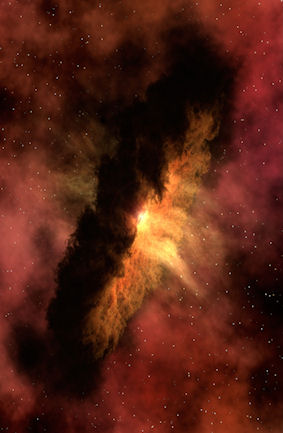
A proto-star star in NGC 1333. Reconstruction
of a possible look of a proto-planetery disk based on a Spitzer Space
Telescope image. An evidence was found for water vapor in the
surrounding area, which appears to be one of the key moments in the
development of a planetary system around such a star: icy material is
falling from the envelope that birthed the star onto a dense,
surrounding disc. Credit: NASA/JPL-Caltech/R. Gutermuth (Harvard-Smithsonian Center for Astrophysics)
|
|
During star formation, the central part of a dense molecular cloud
collapses to a proto-star with a gaseous envelope that finally settles
to a rotating proto-planetary accretion disc. Sedimentation and
self-gravity in such discs trigger the formation of planets and
planetary systems. Proto-stars are heavily embedded in surrounding gas
and dust and for this reason visible only in the infrared, millimetre or
sub-millimetre wavelength bands. Most of the material that goes into
forming a star is accreted through a circumstellar disc and in this
process the proto-stellar system drives an energetic bipolar jet and
outflow into its surroundings. The least evolved proto-stars are
surrounded by remnant proto-planetary accretion discs.
Based on the spectral energy distribution in the infrared and visible
light, YSOs are divided into five classes (0-IV), associated with their
evolutionary stages. Class 0 refers to collapsing molecular clouds,
proto-planetary discs exist in classes I-III, and class IV contains the
zero-age main-sequence star.
A related issue: the extrasolar planets
|
Accretion discs in cataclysmic variables (CVs)
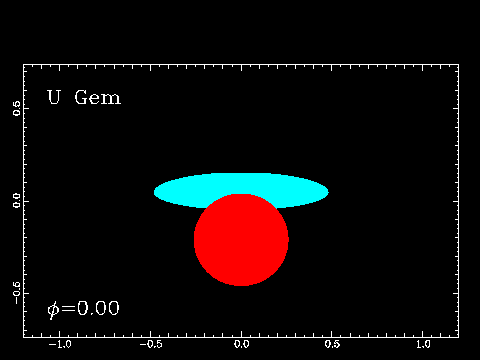
U Gem system, as it would be seen from the
Earth. In reality, the image of the system is unresolved, and only the
total flux from the secondary (red) and accretion disc (blue) is
observed. The primary white dwarf is located at the centre of the
accretion disc (too small to be seen). The secondary and the accretion
disc periodically eclipse each other, which results in periodic
variations in the observed flux (photometry) and spectral features
(spectroscopy). From these variations Smak (1971) reconstructed size and shape of the accretion disc.
|
CVs are binary star systems consisting of a white dwarf ("primary")
and a normal star ("secondary", or "companion"). Typically, the CVs have
sizes comparable to the Earth-Moon system, and orbital periods of a few
hours. When the outer layers of the companion overflow the "Roche
lobe", the companion loses matter through the first Lagrangian point  of the rotating binary system. When the white dwarf is only weakly
magnetised, the matter forms an accretion disc around it and eventually
reaches its surface. "Dwarf novae" (DN) are CVs that show outbursts
lasting for about a week and separated by weeks to months of quiescence.
U Gem is the prototype of dwarf novae. The brightness in the visible
light of U Gem increases 100-fold every 120 days or so, and returns to
the original level after a week or two. The DN phenomenon is due to a
specific accretion disc limit-cycle instability, tidal torques, and
fluctuations in the mass-transfer rate from the secondary. The geometry
of accretion is very different in magnetic CVs, where accretion discs
are either truncated or absent and accretion occurs along the magnetic
field lines.
of the rotating binary system. When the white dwarf is only weakly
magnetised, the matter forms an accretion disc around it and eventually
reaches its surface. "Dwarf novae" (DN) are CVs that show outbursts
lasting for about a week and separated by weeks to months of quiescence.
U Gem is the prototype of dwarf novae. The brightness in the visible
light of U Gem increases 100-fold every 120 days or so, and returns to
the original level after a week or two. The DN phenomenon is due to a
specific accretion disc limit-cycle instability, tidal torques, and
fluctuations in the mass-transfer rate from the secondary. The geometry
of accretion is very different in magnetic CVs, where accretion discs
are either truncated or absent and accretion occurs along the magnetic
field lines.
There is a solid observational evidence for accretion discs in CVs based on very accurate photometry and spectroscopy.
|
Most galaxies have supermassive (millions to billions of solar masses) black holes
at their centres (nuclei). In AGN, the black hole accretion produces
radiative power that usually outshines its host galaxy. The accretion
disc is surrounded by a hot corona which contains clouds of gas. Fast
moving clouds produce broad lines (BRL) and slow moving clouds produce
narrow lines (NRL) in the AGN spectra. A large torus of gas and dust
partially obscures the central part, which affects the observed
appearance of an AGN, as Figure 4 explains.

AGN unification scheme. Green arrows indicate the AGN type that is seen from a certain viewing angle
|
Property |
Quasars |
Seyfert Galaxies |
Radio Galaxies
|
Blazars |
| Galaxy type |
Spiral, Elliptical |
Spiral |
Giant Elliptical |
Elliptical |
| Appearance |
compact, blue |
compact, bright nucleus |
elliptical |
bright, star-like |
| Maximum luminosity |
100-1,000 Milky Way |
comparable to bright Spirals |
strong radio |
10,000 Milky Way |
| Continuum spectrum |
non-thermal |
non-thermal |
non-thermal |
non-thermal |
| Absorbtion lines |
yes |
none |
yes |
none |
| Variability |
days to weeks |
days to weeks |
days |
hours |
| Radio emission |
some |
weak |
strong |
weak |
| Redshifts |
z > 0.5 |
z ~ 0.5 |
z < 0.05 |
z ~ 0.1 |
AGN are generally divided into two families, "radio loud" and "radio
quiet", depending on whether they exhibit jets or not. The viewing angle
gives rise to several AGN types that are distinguished by their
emission properties. Among them, the spiral galaxies with broad and
narrow emission lines (Seyfert 2) or galaxies with just narrow emission
lines (Seyfert 1, where the dust torus obscures the BLR) and their
counterparts in the radio loud family, the broad line (BLRG viewing
angle above ~60°) and narrow line radio galaxies (NLRG viewing angle
below ~60°) with jets and radio lobes perpendicular to the accretion
disc, as well as radio loud and radio quiet quasars (i.e. quasi-stellar
objects). The latter are the most luminous beacons in the universe and
observed up to highest redshifts, implying cosmological distance and
gigantic energy output. Therefore, despite their name, quasi-stellar
objects are anything but stars. However, because quasars shine at such
large distances, it is not possible to resolve the bright core. Recent
observations detect jets and nebulosity around some of them.
Accretion discs in Microquasars and X-ray binaries
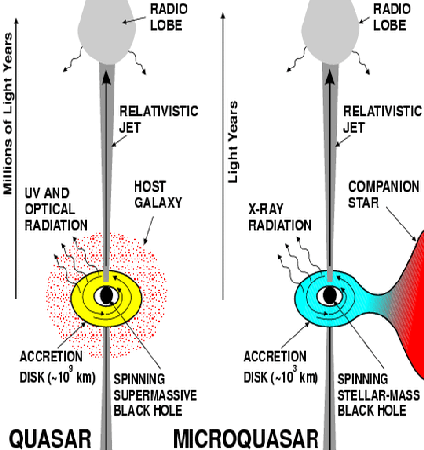
Microquasars found in several X-ray binaries
in our Galaxy are scaled down versions of quasars, as pointed out by
Felix Mirabel, who also coined the name "microquasar". This figure first
appeared in several of Mirabel's articles.
|

Black hole X-ray binaries in our Galaxy. The
figure shows the companion star and the accretion disc drawn to scale.
For a comparison, the Sun - Mercury distance is shown. (Figure by Jerome
Arthur Orosz).
|
Main-sequence secondary stars in orbit with accreting neutron stars
or black holes (neutron star binaries or black hole binaries,
respectively) are common objects in the Galaxy. Neutron stars are often
magnetised, especially young ones, such that their accretion discs are
disrupted by magnetic fields or do not exist at all. Matter in these
cases is lead by partial or total column accretion to the compact
object. In comparison to CVs their spectral energy distribution is
observed up to the X-ray regime, since neutron stars and black holes
have a much stronger gravitational potential. X-ray binaries are,
depending on the mass of the companion star, roughly divided into two
categories, the low-mass X-ray binaries, LMXBs (in figure 6, systems
with coloured companion), and the high-mass X-ray binaries, HMXB (in
figure 6, systems with white companion), where soft X-ray transients and
X-ray pulsars are respective sub-classes. Soft X-ray transients with
NSs or BHs show quasi-periodic
outbursts. Many, if not all, black hole X-ray binaries exhibit in
addition relativistic twin jets that propagate along the rotational axis
of the compact object and are called microquasars.
Accretion discs in gamma ray bursts (GRBs)
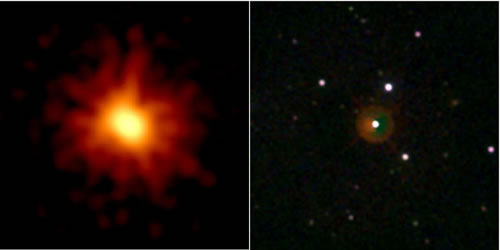
Afterglow of the gamma-ray burst captured in
X-ray (left) and UV/optical (right) on 19.03.2008. At peak, this GRB was
visible with the naked eye. (Credit: NASA/Swift/Stefan Immler)
The most energetic explosions seen in the universe are gamma-ray bursts. They are short, collimated flares of low-energy  -rays
with relativistic emission simultaneously also at longer wavelengths
(e.g., X-ray flashes, radio jets). Observations indicate that GRBs are
cosmological and followed by slowly fading afterglows. The duration of
GRB prompt emission can last from 0.01 - 2 seconds (short bursts) up to 2
- 500 seconds (long bursts) and may be explained by merging compact
objects or failed supernovae (collapsars), respectively. Afterglows on
the other hand are observed and monitored from a couple of days up to
several years. All evidence on the origin of the inner engines (i.e.,
mergers, collapses, pulsars) of GRBs is deduced indirectly. Energetic
requirements suggest, however, a similar configuration of the end
products: the formation of a solar-mass black hole surrounded by a
massive debris disc (~ 0.1 Msun) with a huge accretion rate.
The time scale of the burst is determined by the accretion time of this
disc. According to these time scales accretion discs in GRBs are most
likely hyper-accreting. This means, the temperatures and densities at
the required accretion rates are such, that neutrino production is
switched on and the electrons are mildly relativistic and degenerate.
Generally, GRBs seem to show similarities to radio-loud AGN and galactic
microquasars, since all these systems eject strongly collimated, more
or less relativistic flows of matter and involve accretion onto a black
hole. -rays
with relativistic emission simultaneously also at longer wavelengths
(e.g., X-ray flashes, radio jets). Observations indicate that GRBs are
cosmological and followed by slowly fading afterglows. The duration of
GRB prompt emission can last from 0.01 - 2 seconds (short bursts) up to 2
- 500 seconds (long bursts) and may be explained by merging compact
objects or failed supernovae (collapsars), respectively. Afterglows on
the other hand are observed and monitored from a couple of days up to
several years. All evidence on the origin of the inner engines (i.e.,
mergers, collapses, pulsars) of GRBs is deduced indirectly. Energetic
requirements suggest, however, a similar configuration of the end
products: the formation of a solar-mass black hole surrounded by a
massive debris disc (~ 0.1 Msun) with a huge accretion rate.
The time scale of the burst is determined by the accretion time of this
disc. According to these time scales accretion discs in GRBs are most
likely hyper-accreting. This means, the temperatures and densities at
the required accretion rates are such, that neutrino production is
switched on and the electrons are mildly relativistic and degenerate.
Generally, GRBs seem to show similarities to radio-loud AGN and galactic
microquasars, since all these systems eject strongly collimated, more
or less relativistic flows of matter and involve accretion onto a black
hole.
|
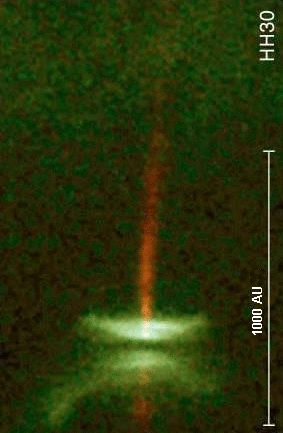


 of the rotating binary system. When the white dwarf is only weakly
magnetised, the matter forms an accretion disc around it and eventually
reaches its surface. "Dwarf novae" (DN) are CVs that show outbursts
lasting for about a week and separated by weeks to months of quiescence.
U Gem is the prototype of dwarf novae. The brightness in the visible
light of U Gem increases 100-fold every 120 days or so, and returns to
the original level after a week or two. The DN phenomenon is due to a
specific accretion disc limit-cycle instability, tidal torques, and
fluctuations in the mass-transfer rate from the secondary. The geometry
of accretion is very different in magnetic CVs, where accretion discs
are either truncated or absent and accretion occurs along the magnetic
field lines.
of the rotating binary system. When the white dwarf is only weakly
magnetised, the matter forms an accretion disc around it and eventually
reaches its surface. "Dwarf novae" (DN) are CVs that show outbursts
lasting for about a week and separated by weeks to months of quiescence.
U Gem is the prototype of dwarf novae. The brightness in the visible
light of U Gem increases 100-fold every 120 days or so, and returns to
the original level after a week or two. The DN phenomenon is due to a
specific accretion disc limit-cycle instability, tidal torques, and
fluctuations in the mass-transfer rate from the secondary. The geometry
of accretion is very different in magnetic CVs, where accretion discs
are either truncated or absent and accretion occurs along the magnetic
field lines.



 -rays
with relativistic emission simultaneously also at longer wavelengths
(e.g., X-ray flashes, radio jets). Observations indicate that GRBs are
cosmological and followed by slowly fading afterglows. The duration of
GRB prompt emission can last from 0.01 - 2 seconds (short bursts) up to 2
- 500 seconds (long bursts) and may be explained by merging compact
objects or failed supernovae (collapsars), respectively. Afterglows on
the other hand are observed and monitored from a couple of days up to
several years. All evidence on the origin of the inner engines (i.e.,
mergers, collapses, pulsars) of GRBs is deduced indirectly. Energetic
requirements suggest, however, a similar configuration of the end
products: the formation of a solar-mass black hole surrounded by a
massive debris disc (~ 0.1 Msun) with a huge accretion rate.
The time scale of the burst is determined by the accretion time of this
disc. According to these time scales accretion discs in GRBs are most
likely hyper-accreting. This means, the temperatures and densities at
the required accretion rates are such, that neutrino production is
switched on and the electrons are mildly relativistic and degenerate.
Generally, GRBs seem to show similarities to radio-loud AGN and galactic
microquasars, since all these systems eject strongly collimated, more
or less relativistic flows of matter and involve accretion onto a black
hole.
-rays
with relativistic emission simultaneously also at longer wavelengths
(e.g., X-ray flashes, radio jets). Observations indicate that GRBs are
cosmological and followed by slowly fading afterglows. The duration of
GRB prompt emission can last from 0.01 - 2 seconds (short bursts) up to 2
- 500 seconds (long bursts) and may be explained by merging compact
objects or failed supernovae (collapsars), respectively. Afterglows on
the other hand are observed and monitored from a couple of days up to
several years. All evidence on the origin of the inner engines (i.e.,
mergers, collapses, pulsars) of GRBs is deduced indirectly. Energetic
requirements suggest, however, a similar configuration of the end
products: the formation of a solar-mass black hole surrounded by a
massive debris disc (~ 0.1 Msun) with a huge accretion rate.
The time scale of the burst is determined by the accretion time of this
disc. According to these time scales accretion discs in GRBs are most
likely hyper-accreting. This means, the temperatures and densities at
the required accretion rates are such, that neutrino production is
switched on and the electrons are mildly relativistic and degenerate.
Generally, GRBs seem to show similarities to radio-loud AGN and galactic
microquasars, since all these systems eject strongly collimated, more
or less relativistic flows of matter and involve accretion onto a black
hole.